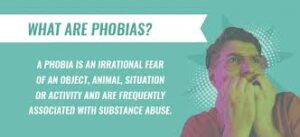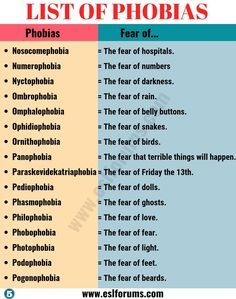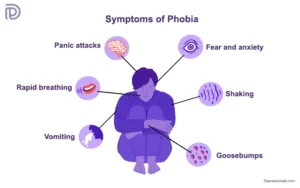How phobias are affecting your life?
When a person has a phobia, they will often shape their lives to avoid what they consider to be dangerous. The imagined threat is greater than any actual threat posed by the cause of terror.
Phobias are diagnosed mental disorders.
The person will experience intense distress when faced with the source of their phobia. This can prevent them from functioning normally and sometimes leads to panic attack.
The impact of a phobia can range from annoying to severely disabling. People with phobias often realize their fear is irrational, but they’re unable to do anything about it. Such fears can interfere with work, school, and personal relationships.
An estimated 19 million Americans have a phobia that causes difficulty in some area of their lives. Seek the help of your doctor if you have a fear that prevents you from leading your fullest life.

WHAT IS PHOBIA?
A phobia is an excessive and irrational fear reaction. If you have a phobia, you may experience a deep sense of dread or panic when you encounter the source of your fear. The fear can be of a certain place, situation, or object. Unlike general anxiety disorders, a phobia is usually connected to something specific.
Some phobias are very specific and limited. For example, a person may fear only spiders (arachnophobia) or cats (ailurophobia). In this case, the person lives relatively free of anxiety by avoiding the thing he or she fears. Some phobias cause trouble in a wider variety of places or situations. For example, symptoms of acrophobia (fear of heights) can be triggered by looking out the window of an office building or by driving over a high bridge. The fear of confined spaces (claustrophobia) can be triggered by riding in an elevator or by using a small restroom. People with these phobias may need to alter their lives drastically. In extreme cases, the phobia may dictate the person’s employment, job location, driving route, recreational and social activities, or home environment.

Types Of Phobia
There are three major types of phobia:
Specific phobia
This is most common form of phobia, people may fear specific animals ( such as spider, cat , snakes etc.) , peoples ( such as clown, doctor, lawyer etc.) environment ( such as dark place, thunderstorm, high place etc.) or specific situation ( such as travelling in airplane, train , car etc. ) . These problem inherited or run in families.
Social Phobia
People with this phobia fear the social situations where they get embarrassed, judge by people . They become uncomfortable when unfamiliar people are involved, so that phobic person avoid social gathering, eating in gathering. This disorder run in families, or people who shy such as child or people with negative social experience in childhood prone to it.
Agoraphobia.
Agoraphobia word refer “fear to open place” This is a fear of being in public places where it would be difficult or embarrassing to make a sudden exit. A person with agoraphobia may avoid going to a movie or a concert, or travelling on a bus or a train. Many people with agoraphobia also have panic symptoms or panic disorder (which involves intense fear plus uncomfortable physical symptoms, such as trembling, heart palpitations and sweating).
Childhoods phobia occur at age to 5 to 9 but it remain for a short period of time but the adult phobia last for long time.
There are some other types of Phobia such as:
Glossophobia: The fear of speaking in front of an audience.
Acrophobia: This is the fear of heights.
Claustrophobia: This is a fear of enclosed or tight spaces.
Aviophobia: This is also known as the fear of flying.
Dentophobia: Dentophobia is a fear of the dentist or dental procedures.
Hemophobia: This is a phobia of blood or injury.
Arachnophobia: This means fear of spiders.
Cynophobia: This is a fear of dogs.
Ophidiophobia: People with this phobia fear snakes.
Nyctophobia: This phobia is a fear of the nighttime or darkness.

SYMPTOMS:
A person with a phobia will experience the following symptoms. They are common across the majority of phobias:
- a sensation of uncontrollable anxiety when exposed to the source of fear
- a feeling that the source of that fear must be avoided at all costs
- not being able to function properly when exposed to the trigger
- acknowledgment that the fear is irrational, unreasonable, and exaggerated, combined with an inability to control the feelings
A person is likely to experience feelings of panic and intense anxiety when exposed to the object of their phobia. The physical effects of these sensations can include;
- sweating
- abnormal breathing
- Fast heartbeat
- trembling
- hot flushes or chills
- a choking sensation
- chest pains or tightness
- butterflies in the stomach
- pins and needles
- dry mouth
- confusion and disorientation
- nausea
- dizziness
- headache
A feeling of anxiety can be produced simply by thinking about the object of the phobia. In younger children, parents may observe that they cry, become very clingy, or attempt to hide behind the legs of a parent or an object. They may also throw tantrums to show their distress.


CAUSES:
People with ongoing medical conditions or health concerns often have phobias. There’s a high incidence of people developing phobias after traumatic brain injury, substance abuse and depression are also connected to phobias.
RISK FACTOR:
people with a genetic predisposition to anxiety may be at high risk of developing a phobia. Age, socioeconomic status, and gender seem to be risk factors only for certain phobias. For example, women are more likely to have animal phobias. Children or people with a low socioeconomic status are more likely to have social phobias. Men make up the majority of those with dentist and doctor phobias.
Author


